![]()
![]()
![]()

David and Goliath ... but this time David forgot his slingshot !!
![]()
![]()
The Italian tankers ("Carristi") saw action, however, in many places other than in North Africa,
![]()
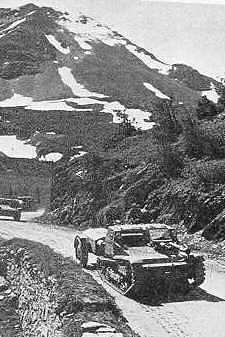 |
France The French "campaign" (June 17-24, 1940) sole target was that of "getting
some cold-meat to throw on the Victory's table for playing the Winner's role" in
a war which was (then !) considered merely a few weeks lasting nuisance. |
Although the Italian "tanks" were never involved in combat, quite a few of these "death-traps", were actually lost either on the vast minefields placed on the western front, or because hitten by artilleries. The Italian losses totaled 631 dead, 2,631 wounded, 616 missing in action, and 2,151 frostbitten !
![]()
East Africa As a result of the Abyssinian War (1935-36), Italy had obtained its "Empire"
(or its "Place in the Sun"] in East Africa, as well as a stable presence
in the region. This dominant position made easy to kick out the British from the
Somaliland, an area practically surrounded by Italian dominions. |
|
well known results in terms of so many lives lost to achieve useless
results) the aforementioned French campaign, gained an advantage over the military one.
Accordingly, the instructions given to the Duke of Aosta (the "Viceroy'") were :
"Maintain a defensive position, in view of the forthcoming defeat of the British
Army"
This task was made easier, at least at an early stage of the operations, by the British
acceptance of the fascist propaganda, which had grossly overstated the power of the
Italian East African forces. Actual armored warfare was limited to 24 medium tanks (M11/39) , 35 light tanks (CV35), and some
armored cars (generally not the updated models). In addition to these vehicles, the
Italians could also have at their disposal some trucks to modify ("nil
sub sole novum"... the Belgians already did it during the early days of WWI )
as additional armored vehicles.
Moreover, unfortunately (for us!), the Italian General High Command
and Army top ranks were definitely neither "Guderians" nor "Von
Mansteins" and therefore worn down their armored forces in non strategic actions,
back and forth in the East African war theater.
On the opposite side, the British widely used armored vehicles, facilitated by the fact
that the Italians lacked efficient anti-tank weaponry. Northern borders were patrolled by
the 4th and 6th Tank Regiment, while the Kenyan border was controlled by strong South
African units.
In January 1941, near Agordat, there were the hardest tank combats of the
entire campaign : Italian ligth tanks (guess which ...yeah ! the
"famous" CV35) against British medium and
heavy tanks (the Matilda II) of the 4th Royal Tank Regiment's B
Squadron.
The rest of the story couldn't be other than this : by mid 1941 the Italian units, lacking
anti-tanks weaponry, aircraft protection, and adequate supplies, were no longer a match
for the strong British armored units, equipped with a number of different, highly
efficient vehicles : from the Bren carrier tankettes to the light tanks, from the medium
to the heavy "cruiser" and "infantry" tanks, not to mention a few
hundreds of armored cars.
In spite of the obstinate, but hopeless, resistance offered by some garrison ( one of the most glorious examples is the siege Culquaber),
the Italians finally surrendered on November 27, 1941 ... and the curtain
dropped down on the stage of the "Italian Empire" ! .
![]()
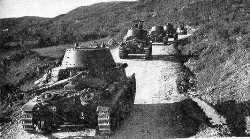 |
Balkans On October 28, 1940 Italy attacked Greece. This action, unjustified, poorly planned, lacking logistic organization and warfare resources, and (on top of all the rest) decided without the agreement, and even the knowledge, of the "Big German Brother", remains in the Italian |
| history as one of the worse examples of the incompetence, carelessness, tactical
uncertainties ("strategy" was an unknown word), and gross stupidity typical of
the Fascist High Command's attitude as well as of the many "desk warriors"
from the Army top ranks. In addition to the aforementioned organizational failures, the campaign's conduct was influenced by other factors, like the terrain structure |
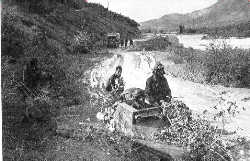 |
(high and steep mountains, in Greek hands, and small plains and narrow
valleys, kept by the Italians) and bad weather which, in addition to the other negative
effects for the offenders, precluded to the Italians the possibility to widely use their
tanks. (*).
Under these circumstances the tanks saw only marginal actions, which, however, proved the
courage and valour of the Italian tankers.

![]()
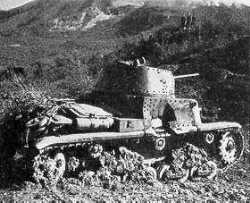
"Siena" infantry division units, supported by M13 tanks at
"Quota 731" Ugo Passalacqua's (Gold Medal) tank destroyed at Klisura (27.1.1941)
(*) At the war outbreak, the Italian armored warfare was represented by the Centauro division, deployed in Albania (just across the Greek border) with 163 light tanks and some M13/40 medium tanks.
In March 1941, the British landed in Greece with a task force of some
58,000 troopers (two infantry divisions and one armored brigade, comprising about 100 A10
heavy cruiser tanks Mark II).
As a response the Germans, giving support to the Italians, deployed a massive army :18
infantry, 4 motorized, and 10 armored divisions (sic !)
which, while moving towards the Greek frontline, invaded Jugoslavija and in twelve days
conquered the entire region. During this balkanian war appendix, the Italians, in
addition to the Centauro already located in Albania, moved from its Northern Italy
location, the Littorio armored division.
The Balkanian campaign ended on April 24, 1941, when the Greeks surrendered. and the British troops started moving back to their Egyptian bases, leaving in Greece all their tanks.
![]()
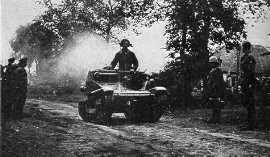 |
Russia The Italian presence on the Russian frontline was somehow material in terms of men but totally marginal in terms of armored resources. The CSIR (Corpo di Spedizione Italiano in Russia), a 60,000 troops Corps, |
| and later the ARMIR (ARMata Italiana in Russia), a 200,000 troops Army, deployed, during the entire campaign, 55 L33/35 ligth tanks of the Gruppo Squadroni Carri Veloci "S.Giorgio" (a cavalry unit of the 3. Divisione Celere), some 60 L6/40 ligth tanks of the 67� Battaglione Bersaglieri, and some 15 Semoventi da 47 (self-propelled guns derived from the L6 ligth tank). These tanks, being absolutely useless in case of combat with other tanks (could you imagine an L6/40 against a T34/76 or a KV-1 ??), were used as support to infantry and alpine units. All the tanks and the SP guns disappeared during the disastrous retreat (more than 100,000 Italian soldiers died or were reported as missing in action) which concluded the campaign, after the fall of Stalingrad. | 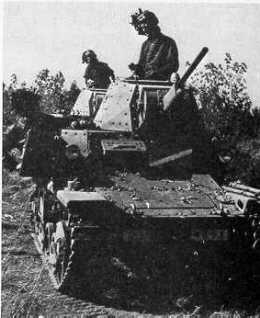 |
![]()
 |
The Defense of Rome The conduct of the war event known as "The defense of Rome" (DoR) is emblematic of the confusion which ruled the days of the armistice. |
The Italian units deployed around Rome comprised :
Inside Rome there was the "Corpo d'Armata di Roma" (Rome Army Corps) which comprised : the "Sassari" infantry division, an artillery command with 42 batteries, the 4th Tank Regiment, the "A" motorized assault batallion, as well as other smaller units.
Obviously the defender troops backbone was represented by the CAM armored units, which consisted of :
| Resources | Ariete II |
Centauro II |
Piave |
| Troops | 7.500 |
5.500 |
6.000 |
| Tanks and SP guns | 40 |
79 |
69 |
| Armored cars | 50 |
15 |
.. |
| Guns | 70 guns |
24 guns 88/76 |
88 guns |
| MG anti-aircraft | 92 MG 20mm |
.. |
48 MG 20mm |
Including the resources of the other units deployed inside or around Rome, the total strength available for the town defense was of 63.000 troops, and 412 armored vehicles (tanks, SP guns, and armored cars).
The German attacking units were the 2nd Fallschirmiaeger (paratroopers) and the 3rd Panzergrenadier divisions, totalling about 26.000 troops, and 200 armored vehicles (tanks, SP guns, and armored cars).
![]()
To make a long story short, the Defense of Rome timeline can be summarized as follows :
The courtain drops on the "Flea Circus" bloody stage...
|
 |
![]()
![]() Back to Homepage
Back to Homepage
![]()
![]() I'd be
delighted if you filled one page of my Guestbook
I'd be
delighted if you filled one page of my Guestbook
![]()
Page established on : December 22, 1997
Last update : February 4, 1998
This page is maintained by Mario Paesani .....the webmaster !
This page hosted by ![]() Get your own Free Home Page
Get your own Free Home Page